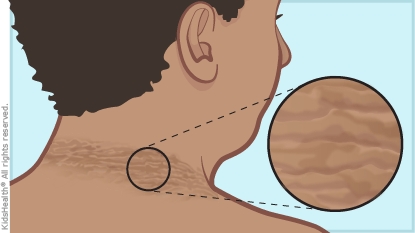Acanthosis Nigricans: How to Care for Your Child
In acanthosis nigricans, kids get thick, dark, and sometimes streaky patches on their skin. The patches might feel like velvet. They usually affect areas with skin folds, such as the neck, armpits, elbows, knees, and groin, but they can appear anywhere on the body. They are not contagious. Sometimes parents or children may think the dark skin is dirty, but it isn't. Scrubbing the skin does not help and can cause irritation.
The dark skin patches that appear in acanthosis nigricans (ah-kan-THO-sis NY-gruh-kans) are harmless, but this condition can be a sign of diabetes or other health problems.


-
Do not use skin bleaches or scrubs on the patches.
-
Wash the skin gently. Scrubbing the patch roughly can irritate the skin.
-
If your child is overweight, follow the weight-loss plan prescribed by your health care provider. This might include:
-
Limiting fast foods and sugary treats in your child's diet.
-
Encouraging your child to drink water instead of soda, juice, or sugary drinks.
-
Serving healthy foods like whole grains, vegetables, fruits, lean meats, fish, beans, nuts, and low-fat dairy products.
-
Encouraging your child to be physically active at least 60 minutes each day. Help your child find fun types of exercise, such as team sports, dancing, walking, running, or active games like tag.
-
Giving your child any prescribed medicines as directed by your health care provider.

Your child:

Your child:
-
has unexplained stomach pain, nausea, or vomiting
-
has deep, rapid breathing
-
is extremely drowsy, confused, or unconscious

What causes acanthosis nigricans? The cause isn't clear. But the condition can happen in kids and teens who:
-
are overweight
-
have high levels of the hormone insulin in their blood
-
have or are at risk for having type 2 diabetes
-
are having a reaction to a medicine, such as oral contraceptives or steroids
-
have another medical condition, such as polycystic ovary syndrome or thyroid disease. Very rarely, it can be a warning sign of some types of cancers.
-
come from a family whose members also have it, because it can run in families
Acanthosis nigricans can also happen in someone who is otherwise healthy.
How is acanthosis nigricans treated? If there is a related condition, such as diabetes or thyroid disease, treating that condition can often make the skin patches fade or disappear. If your child is overweight, reaching and maintaining a healthier weight might help improve the skin's appearance. If acanthosis nigricans happens due to a medicine, stopping the medicine might help.
Sometimes health care providers prescribe a cream or lotion to help lighten the skin, but it is unclear whether such treatment works well.